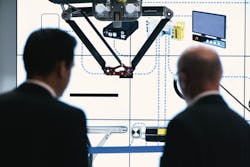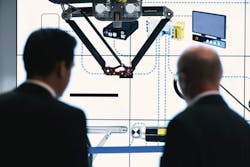5 Material Handling Trends in the Auto Industry
Download the PDF version of this article here.
In just 70 years, material handling in the automotive industry has gone through numerous transformations, going from assembly lines manned by individual workers, to assembly lines of modern material handling machines, robots, and knowledge workers. Thanks to that transformation in production, the total output of automotive manufacturers increased nearly 10 times over in the 35 years after World War II.
Today, R&D programs such as Stuttgart’s ARENA2036, are reimagining what the next generation of automobile manufacturing plants will look like in a world that is more connected and data-driven than ever and supported by agile production systems.
Material handling developments are, therefore, trending in the same direction. Industry faces challenges that include market saturation and overcapacity, increasing variability between car models driven by shorter time-to-market demands, international competition, and a changing regulatory environment. These challenges are being overcome with innovations in flexible production, seamless digital process chains, and big data for smart factories that give engineers and managers a full transparency into production and logistics.
Smart manufacturing and material handling go beyond single-machine diagnostics to leverage collective big data and deliver real business intelligence to automotive manufacturers, OEMs, and CMs on how to improve systems both as a whole and on an individual part level.
We are entering a new era of automotive manufacturing, one that relies on “smart” factories. And these “smart” factories will require a dramatically different approach to material-handling equipment and systems to make this new kind of production possible. So here are the top five trends that will likely make the biggest impact on how automotive manufacturers do business, and what industry leaders are already doing to meet demand for these innovations.
1. Agile/Flexible Production
Today’s assembly lines are based on linear or modular production and rely on rigid, single-purpose machines. However, the forecast for vehicles and what customers want in the future is not very stable. Will the production line be required to turn out more SUVs rather than small cars or an unknown mix of standard engines, hybrids, and e-cars? Which particular features will be more popular than others? When market desires change, it is always a challenge for the production line to respond.
Automakers who want to be agile will need flexible material handling equipment. A new mix of fix conveyors, automated transports such as guided vehicles (AGVs) for material flow, mobile tool carriers, and shuttles will be developed and put higher demands on logistics controls. The increasing number of autonomous vehicles to support the new fenceless production architecture will need new safety features.
Equipment and controls that support tight, variant, and cross-linked production will become essential elements of this responsive, cell-based automotive manufacturing. Additionally, as machines and workers interact in more flexible, fenceless production areas, material handling equipment will also require advanced safety features.
Agile/flexible production will need several changes, including:
- A production floor responsive to customer behavior and market demands.
- Faster times-to-market for new concepts.
- Elimination of unstable production utilization.
- 24-hour, 7-days-per-week production.
- Maximum automation with minimal labor
So auto makers should look for suppliers that offer:
- Flexible, decentralized solutions.
- Digital engineering tool chain.
- Project team with industry knowledge to install and start up this new production architecture.
2. Total Process Simulation
Almost every new manufacturing or assembly design project for the auto industry is supported by a simulation; and if it isn’t already, it will be. Material handling components play a large role in simulating everything from complete factories to single processes because they put components, fasteners, and finished products in motion. But simulations rely on data and not all suppliers can provide the required information in forms that are easily integrated into an existing simulation tool.
Simulation has been used to guide various aspects of automotive manufacturing for years. The more data system suppliers can provide for these simulations, the closer OEMs and end manufacturers can get to total process simulations that enable more accurate time and resource budgeting, total process cost projections, and material handling systems that result in optimal system investments.
Demand for behavior models for all components in material-handling systems is already growing. That’s because good simulation provides early insights into time and human resource requirements, quality levels, and total process costs. As such, companies are selecting suppliers during the simulation phase more and more often. They base their selection in large part on which providers can best optimize a simulated process.
Total process simulation is the eventual goal, so data integration from all potential suppliers during very early design stages will, therefore, be critical. Total process simulation will then offer solid benefits, such as:
• More accurate and reliable planning.
• Improved ROI through better and earlier resource management.
• Lets companies take advantage of flexible adaptations and modifications before a design is implemented.
So auto makers should look for suppliers that offer:
• Data transfer via standard interfaces and protocols.
• Digital product twins.
• Existing behavior models for intelligent drives.
3. 360-Degree Connectivity
Material handling is already highly automated, but as the digital age progresses, automation will be developed even further due to an increase in connectivity between applications and decentralized solutions. All relevant components of material handling applications or processes will be directly connected to a real-time industrial communication network.
The goal is to have material handling solutions that are easy to integrate within existing infrastructures and efficient to maintain. Material handling solutions will become plug-and-play and tool-less, have self-optimization functions, and parts that can be automatically identified.
Questions such as “What is the status of my machines?” will be answered with a simple click rather than a disruptive systems check. Maintenance, which is currently a fixed system, will evolve into a more mobile and automated digital system.
With fully connected and decentralized material handling, technical support across various vendors and suppliers becomes much easier and, ideally, could eventually become standardized. Asset management and equipment management become fully transparent. With connected drives and a digital dashboard, OEMs can easily run diagnostics, get system warnings in real time, and analyze components in need of regular maintenance or replacement. When there is a failure, programming can be automatically downloaded for a new component or system, a much quicker approach than scheduling a technician to program replacement parts to the existing system.
Once 360-degree connectivity is established, the following is possible:
• Transparent production system analysis and easy optimization.
• Higher availability and reliability of machine lines due to efficient diagnostic and predictive maintenance that reduce machine line downtime.
• More flexible machine parameters including plug-and-play and digitally controlled components.
• Servicing can be done on a communication network or mobile device.
Look for system suppliers that offer:
• Connectivity through standard industrial communication systems.
• Intelligent mechatronic solutions that generate information on a system’s behavior.
• Easy to connect and service with mobile devices or through remote maintenance access.
4. Big Data for Smart Services
OEMs are always looking for a way to provide preventative maintenance and to optimize machine lines for whatever particular need arises on the production floor. A connected, decentralized system is one way to get feedback on a single automotive manufacturing or assembly plant. However, the key to a truly predictive system is much broader and far-reaching.
Assembly lines are not only evolving into something less linear in construction but also more agile and flexible to better respond to market forecasts. Automated, fence-less, cell-based manufacturing, and machines and workers that interact in a less prescriptive way will require material handling equipment that has advanced safety feature and that can support tight, variant, or cross-linked production.
Gathering, monitoring, and analyzing big data from numerous manufacturing and assembly plants, as well as various equipment and controls, can turn data into information and information into the potential for transformative action. Such corporate-wide monitoring and evaluation could increase machine reliability, extend machine life, and boost efficiency through preventative maintenance and process optimization.
Data is only as good as its application, so gathering and analysis are only half the story. The benefits of big data collection for automotive manufacturing and assembly require a way to apply the new business intelligence. For example, companies want a way to deliver data to experienced machine builders who can then make accurate forecasts for maintenance crews, or applications (mobile or otherwise) customized for production teams or machine lines that deliver data-driven recommendations or modifications.
Big data could also be crucial in developing material handling equipment and components that could be used well into the future. As it stands now, material handling equipment could be on automotive assembly lines for nearly a decade, yet OEMs are blind to how they are working and wearing. If OEMs and CMs could analyze real, end-use, machine line data and process intelligence, they could offer products optimized for long-term performance and price.
Big data has the potential to offer benefits that include:
• Predictive maintenance that leads to more reliability and availability of machine lines.
• A seamless digital process chain.
• A transparent logistic process.
• The ability to optimize machine lines and product development.
• More efficient systems design and performance
To get the most benefits from big data, auto companies should deal with suppliers that offer:
• Built-in connectivity.
• Necessary data or information in a standardized protocol.
• App services for tasks such as monitoring and dashboarding.
5. Resource Efficiency
At the end of the day, all of the trends rest on one core desire: resource efficiency. The auto industry is always looking to reduce costs and increase efficiency, and anything that helps do so will likely play a key role in the industry’s future.
For material handling, energy efficiency is an ongoing goal. Even manufacturers who aren’t necessarily leveraging the marketing potential of such efforts often look to save energy as simply a cost-reducing measure.
IoT is clearly influencing how the auto industry designs the next generation of production floors. Achieving 360-degree connectivity means material handling equipment needs to be easily integrated into real-time communication networks that will simplify and mobilize all aspects of diagnostics, maintenance, and optimization.
Auto makers and their suppliers use a host of methods to lower energy use including energy calculations to reduce the likelihood of buying oversized equipment, using energy-efficient components, and adopting optimized logistic. They want to use the best methods and machinery that delivers all the power they need, and no more. A time may come when auto companies ask suppliers how much energy use a machine or component will cause. Then, when planning a project, auto makers will have a clear idea how much energy each component and the overall assembly line will consume.
Energy efficiency provides some obvious advantages, such as:
• Reduced energy consumption and related costs.
• Help lead to carbon neutral production.
• Make planning more accurate and reliable by defining the energy consumption of the new project.
Suppliers that can help lower energy use will offer:
• Energy system calculators.
• Supporting simulation tools with energy consumption data in different modus.
• Components that can store or recover energy power.
• Intelligent drives with energy optimized motion profiles for dedicated applications.
For more information on Lenze, click here.





